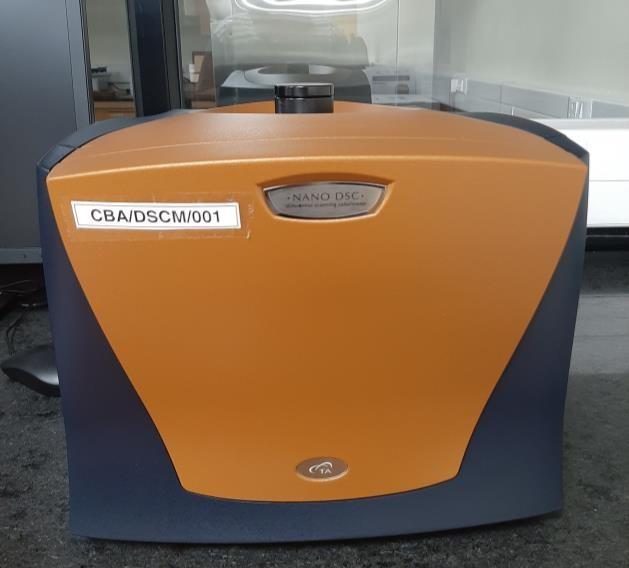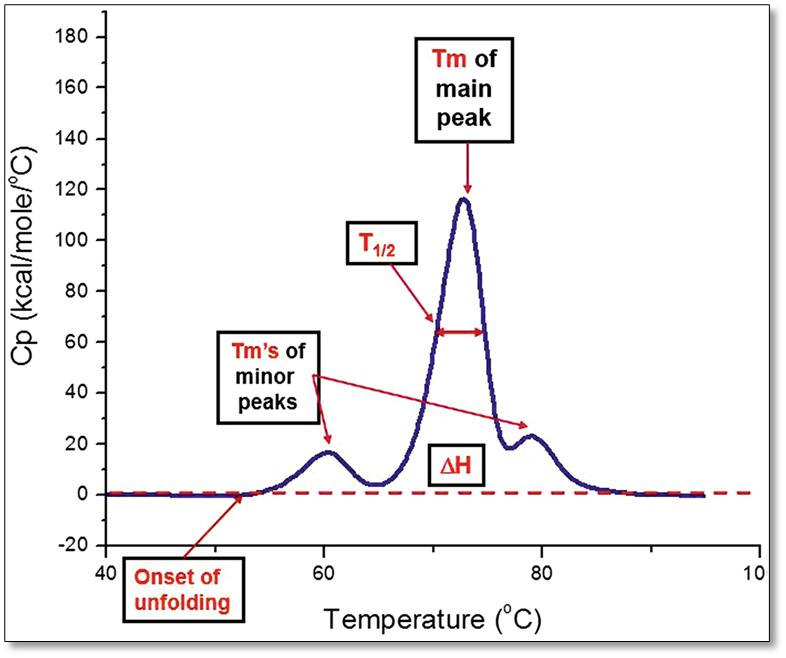DIFFERENTIAL SCANNING CALORIMETRY (DSC)
Differential scanning calorimetry (DSC) is a thermoanalytical technique in which the difference in the amount of heat required to increase the temperature of a sample and reference is measured as a function of temperature. Endothermic samples will need more heat flux during analysis to increase the temperature at the same rate as the reference material. Otherwise, exothermic materials will require less heat flux to raise the temperature. The DSC curve indicates exothermic peaks upward and endothermic peaks downward.

NANO DSC
- The Nano DSC is designed to measure the amount of heat absorbed or released by dilute in-solution bio-molecules as they are heated or cooled. Macromolecules such as proteins respond to heating or cooling by unfolding at a characteristic temperature.
- The more intrinsically stable the biopolymer, the higher the midpoint temperature of the unfolding transition. As these processes often exchange microjoule levels of heat, the sensitivity of the Nano DSC is critical for successful investigation of the reaction.
- The Nano DSC obtains data with less sample than competitive designs and produces unmatched short term noise (±15 nanowatts) and baseline reproducibility (±28 nanowatts).

Nano DSC Specifications
| Short-term Noise | 0.015 µWatts |
| Baseline Stability | ±0.028 µWatts |
| Response Time | 7 seconds |
| Operating Temperature | -10 °C to 130 °C or 160 °C |
| Temperature Scan Rate | 0.05 °C to 2°C/minute |
| Cell Volume | 0.30 ml |
| Cell Geometry | Fixed capillary |
| Cell Composition | Platinum |
| Heat Measurement Type | Power Compensation |
HIGHER ORDER STRUCTURE ANALYSIS BY NANO DSC
Protein maintains its higher order structure using multiple ionic, non-ionic, hydrophobic and other interactions between its subunits. However, at higher temperature when these interactions are disrupted protein unfolds and eventually denatures.
Using Differential Scanning Calorimetry, that collects information on heat release when protein is unfolding, its melting temperature (a temperature where protein denatures) can be measured. Typically, melting temperature of a protein is its unique property and can be used as a comparative parameter to establish integrity of biotherapeutic products.

NANO DSC – CASE STUDY
| Property | Value |
| Name | 210326_Bevacizumab.dsc / scan 1 |
| User | analyst |
| Serial Number | K20342 |
| Start Time | 26-03-2021 13:31:59 |
| Sample Name | Sample Name: 210326_bevacizumab
Concentration – 0.05 M sodium phosphate buffer pH 6.8 |
| Scan Rate (°C/min) | 1.0 |
| Lower Temp
(°C) |
25.0 |
| Upper Temp
(°C) |
100.0 |
| Scan Blank | 210326_blank.dsc / scan 1 |

NANO DSC ANALYSIS AT CBA
| Higher order Structure Analysis using NanoDSC | |
| Sample requirement | Amount- 3-6 ml (1-2 mg/ml)
Formulation buffer- 10 ml |
| Deliverables | Thermogram of specific heat capacity Vs Temperature, apparent Tm |
| Information required from client |
|
